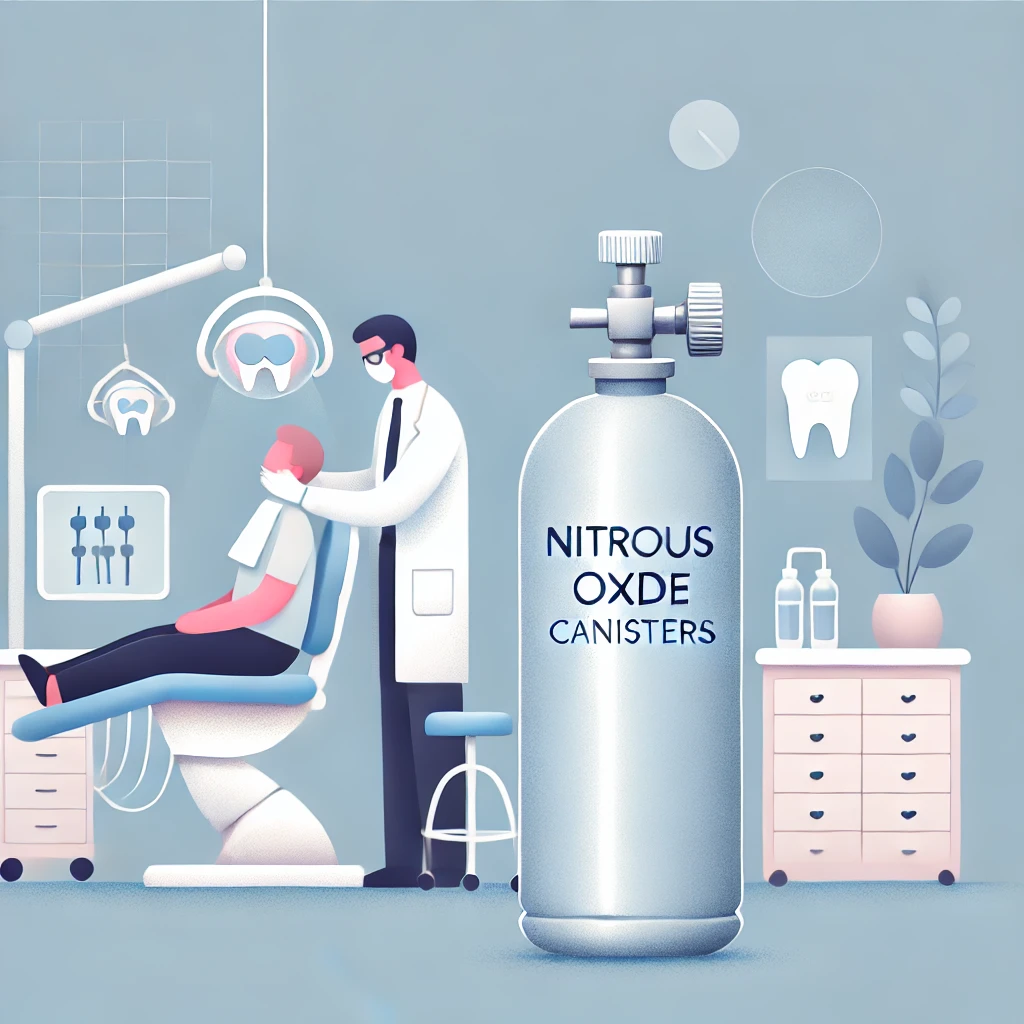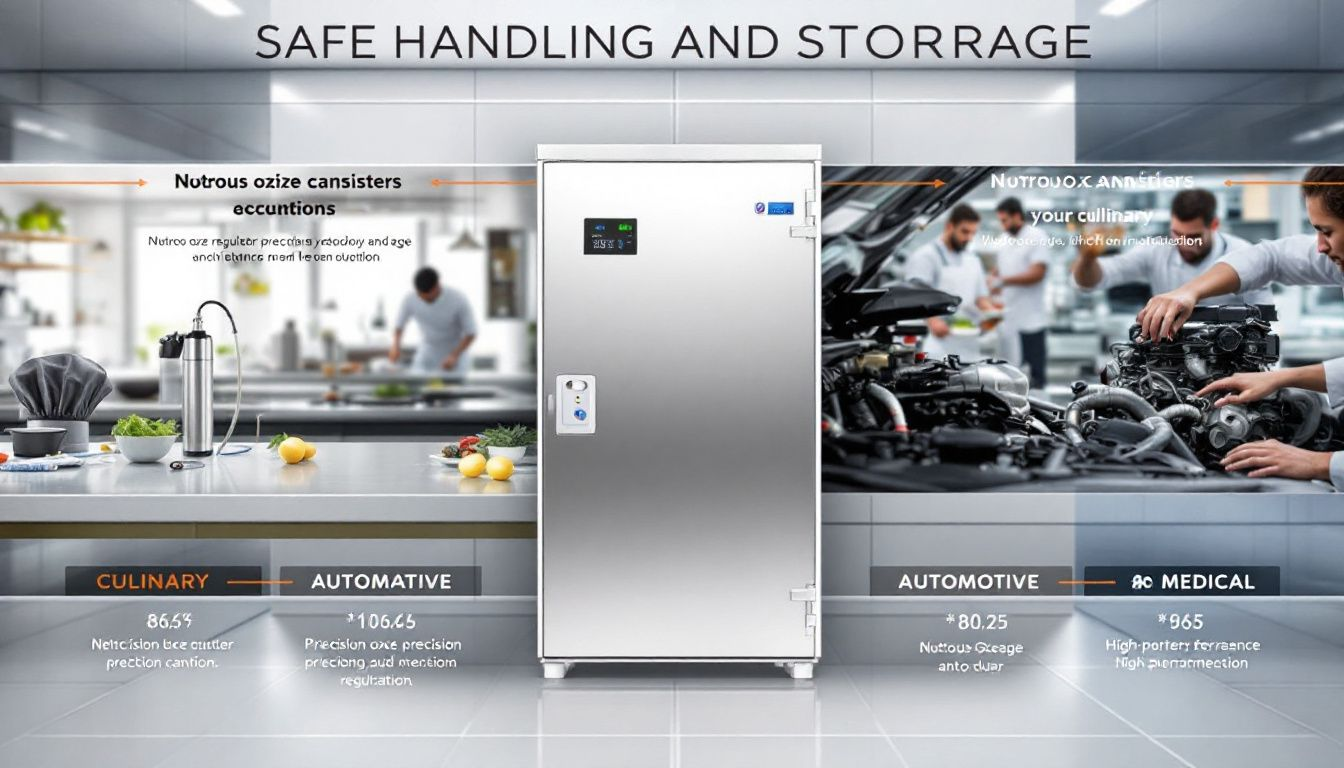
Nitrous Oxide Canisters: Uses, Benefits, and Risks Explained
Share
Nitrous oxide canisters serve important roles in medicine for pain relief, in culinary arts for whipping cream, and recreationally for euphoria. This article provides a detailed exploration of these nitrous oxide canisters uses, their benefits, and the related risks.
Key Takeaways
-
Nitrous oxide canisters are used in medical, culinary, and recreational settings, each with distinct benefits and risks.
-
Recreational use poses significant health risks, including neurological damage and potential for addiction, underscoring the need for awareness and caution.
-
Legal regulations for nitrous oxide vary widely, with strict guidelines for medical and culinary uses but looser restrictions for recreational possession, leading to public health concerns.
Common Uses of Nitrous Oxide Canisters

Canisters of nitrous oxide, commonly known as laughing gas, serve multiple purposes in our daily experiences due to their exceptional adaptability. They are pivotal both in the healthcare sector for providing pain and anxiety relief and within the culinary industry for aerating whipped cream using whipped cream chargers.
Nevertheless, it is its non-medical application that frequently captures public attention due to the dangers associated with its euphoria-inducing properties during social gatherings.
Medical Applications
In the realm of healthcare, nitrous oxide is prized for its anesthetic and pain-relieving qualities. Dentists and surgeons frequently utilize this compound during dental work and less intensive surgical interventions due to its efficacy in alleviating discomfort and anxiety. It serves as a source of patient-controlled analgesia during labor by easing the pain experienced with each contraction.
Dating back to use in the late 1700s to mid-1800s, nitrous oxide has established itself as a mainstay within medical practice. The lawful endorsement of this substance allows individuals undergoing treatment to experience its advantages under the watchful guidance of skilled medical professionals.
Culinary Applications
In the culinary field, nitrous oxide is celebrated for its ability to improve both textures and flavors. Found ubiquitously in professional settings as well as domestic kitchens, whipped cream chargers employ food-grade nitrous oxide. They function by incorporating nitrous oxide into the cream while under pressure, resulting in a fluffy texture that’s crucial for an array of desserts and drinks.
Not limited to just enhancing whipped cream, the utility of nitrous oxide extends to aerating diverse concoctions. The substance is largely regulated with adequate safety protocols which allow people to exploit its advantages without compromising their health.
Recreational Use
Recreational use of nitrous oxide, often called ‘hippie crack,’ is popular at parties and concerts. Users inhale it for brief, intense euphoric effects, including floating sensations and auditory distortions. These transient, pleasurable feelings are appealing, but this practice poses significant health risks.
Using nitrous oxide recreationally can result in serious issues like neurological damage and emotional instability. Despite its popularity, these dangers highlight the need for awareness and caution.
Mechanism of Action and Effects
Understanding the uses and risks associated with nitrous oxide requires knowledge of how it interacts with the brain, its effects on the senses, and its short-lived impact.
How Laughing Gas Works
When nitrous oxide, a compound of nitrogen and oxygen, is inhaled, it affects the brain’s emotional centers by changing perception and dulling sensations. Though its precise mode of action is not fully grasped, the capacity of nitrous oxide to lessen pain and provoke feelings of euphoria has been consistently recognized.
As a main agent that blocks NMDA receptors, nitrous oxide alters neurotransmitter activity which may have antidepressant effects. This effect sheds light on why it is utilized medically for its calming sedative qualities as well as its ability to relieve anxiety.
Sensory Effects
Individuals commonly report that nitrous oxide induces sensations that feel out of this world, including auditory distortions, alterations in sight, a sense of levitation, or experiencing tremors. These sensory effects play a role in the substance’s ability to produce feelings of euphoria and dissociation which is why it is popular for use both medically and recreationally.
When used alongside other substances, the impact of nitrous oxide can be heightened, resulting in stronger and occasionally unforeseen experiences. Such possibilities highlight the importance of using it with caution.
Duration of Effects
Nitrous oxide is known for its short-lived impact, where the induced “high” typically fades in under a minute. While this transient effect might attract those seeking momentary use, there are dangers associated with attempts to prolong the sensation by continuously inhaling it.
Safety and Risks of Using Nitrous Oxide Canisters

This section explores the potential health dangers associated with recreational nitrous oxide usage, including both short-term and long-term risks. It also looks at the perils of mixing this oxide with different substances, despite its legitimate applications.
Short-Term Risks
The utilization of nitrous oxide can lead to immediate side effects such as headaches, dizziness, and a risk of losing consciousness. The extreme coldness of the gas when inhaled straight from a canister poses significant harm to both the lungs and throat. Physical injuries stemming from falls or mishaps have been reported among individuals while they were influenced by nitrous oxide.
There is an inherent danger for grave consequences like suffocation and lung impairment associated with using nitrous oxide that cannot be overlooked. It is critical that there are safety measures in place and a controlled environment during its use to mitigate these short-term risks, highlighting the importance of users being careful and knowledgeable about potential hazards.
Long-Term Risks
Continuous use of nitrous oxide can lead to severe health problems, including a deficiency in vitamin B12 that may cause neurological harm. This shortage impedes the production of myelin and the repair of DNA, which could have grave implications over time.
Inhaling from substantial canisters excessively might result in irreversible damage to the lungs for certain users. These enduring risks underscore the critical need to be aware of the possible repercussions associated with habitual usage of nitrous oxide.
Combining with Other Substances
Blending nitrous oxide with alcohol or other psychoactive drugs can elevate health hazards and lead to erratic outcomes. When paired with alcohol, for instance, the potential for enhanced nausea and a greater chance of vomiting is notable. Such mixtures may also intensify stress on the cardiovascular system, resulting in serious side effects such as an elevated heart rate and heightened blood pressure.
Automotive-grade nitrous oxide contains detrimental impurities that render it unsafe for ingestion by humans. It is vital to recognize these dangers when contemplating recreational use of nitrous oxide.
Legal Aspects of Nitrous Oxide Use

Nitrous oxide’s legal landscape varies widely, with regulations differing significantly for medical, culinary, and recreational uses.
This section details these legal aspects.
Medical and Culinary Use Regulations
The sale of nitrous oxide for the purpose of recreational use is prohibited and subject to strict punishments in various locations, such as certain states in the U.S. and the UK. Nevertheless, it can be legally sold for culinary or medical applications provided that all necessary safety guidelines are observed.
Complying with these stipulated safety measures guarantees its safe and responsible utilization within professional environments.
Recreational Use Laws
Nitrous oxide is not classified as a controlled substance under federal law in the United States, which permits its possession and use. When intended for human consumption, its sale is regulated by the FDA. Numerous state laws place restrictions on the recreational use of nitrous oxide. Notably in New York State where selling it with the intent for intoxication is deemed a misdemeanor.
The misuse of nitrous oxide has raised alarm among communities such that municipalities like Los Angeles are considering prohibiting its sale to address rising incidents among young people. This move signals an escalation in recognizing and combating potential hazards linked to this practice.
Law Enforcement and Public Perception
Typically, law enforcement focuses on pursuing distributors of nitrous oxide who intend it for recreational use rather than its lawful applications. Those caught with the substance usually have to demonstrate that their possession is meant for legitimate uses.
The general view towards sellers of nitrous oxide at concerts and similar events tends to be unfavorable, as they are seen as taking advantage of the situation. This negative public image affects how both law enforcement officials and communities address issues related to the non-medical use of nitrous oxide.
Environmental Impact of Nitrous Oxide Canisters
The environmental impact of nitrous oxide canisters, particularly their production and disposal, is a growing concern.
This section explores these environmental challenges and potential solutions.
Production and Disposal of Nitrous Oxide Chargers
Effective recycling programs are essential to reap the environmental benefits of nitrous oxide canisters made from recyclable steel. If not properly disposed of, they may contribute to landfill waste and emissions of greenhouse gases, underscoring the importance of improved recycling efforts.
Alternatives and Innovations
The foodservice sector is embracing environmentally sustainable options to replace conventional nitrous oxide cartridges. Businesses are introducing green measures, such as canisters that can be reused and recycled, aiming to diminish their ecological footprint.
These advancements lessen the harmful effects on the environment and encourage the prudent utilization of resources in both culinary and industrial realms. These actions are essential for tackling the environmental consequences associated with the use of nitrous oxide.
Responsible Use and Best Practices

Safe and informed use of nitrous oxide requires recognizing its potential effects and associated risks while ensuring a conducive environment.
The following segment offers directions for responsible utilization.
Medical Supervision
The employment of nitrous oxide must invariably occur with the oversight of capable medical professionals to maintain safety. These experts are proficient in dispensing an accurate dose within a controlled medical environment, while vigilantly observing patients for any negative reactions, thereby substantially diminishing potential health hazards.
Having medical authorities supervise the application of nitrous oxide minimizes the chances for grave health issues and guarantees that patients securely attain its planned therapeutic advantages.
Safe Handling and Storage
It is essential to store nitrous oxide canisters correctly to ensure safety. They need to be placed in areas with good ventilation, shielded from direct sun exposure and severe temperature fluctuations. Ensuring that the canisters are upright and firmly secured helps avert mishaps and leakage of gas.
By storing the canisters in an environment that is both cool and dry, their structural integrity remains intact, which also minimizes the danger of them becoming over-pressurized. Adhering to these storage guidelines is key for using nitrous oxide safely and effectively.
Recognizing Abuse and Seeking Help
It is essential to be cognizant of the signs indicative of nitrous oxide misuse in order to facilitate early intervention and provide appropriate support. Identifying patterns of abuse can enable those affected to pursue the help and resources they need.
Summary
In essence, nitrogen oxide serves multiple purposes, ranging from its utilization in medical and culinary fields to being used for entertainment. Despite its beneficial contributions within controlled environments, recreational consumption of this substance can lead to significant health dangers. It is imperative to have a thorough comprehension of how nitrous oxide works, its impact on the body, and pertinent legal constraints to ensure it’s utilized safely and legally.
Adopting recommended practices and complying with official guidelines are key steps individuals should take if they want to harness the advantages provided by nitrous oxide while simultaneously mitigating any associated risks. In our ongoing pursuit of sustainable options and innovative solutions in various domains involving nitrous oxide usage, it remains an important concern that calls for careful handling.
Frequently Asked Questions
What are the common uses of nitrous oxide canisters?
Nitrous oxide canisters are primarily used for medical anesthesia and pain relief, in culinary applications for whipping cream, and recreationally for their euphoric effects.
How does nitrous oxide work in the brain?
By interacting with the emotional centers of the brain, nitrous oxide modifies perception and dampens sensations as it primarily operates as an antagonist to NMDA receptors, influencing neurotransmission.
The result of this interaction is what gives rise to its analgesic and anesthetic properties.
What are the short-term risks of using nitrous oxide recreationally?
The short-term risks of using nitrous oxide recreationally include headaches, dizziness, loss of consciousness, and potential physical injuries from falls.
Additionally, inhaling directly from a canister can cause harm to the throat and lungs.
Are there any legal restrictions on the recreational use of nitrous oxide?
Yes, many regions impose legal restrictions on the recreational use of nitrous oxide, including laws that prohibit its sale and purchase for the purpose of getting high, as seen in places like New York.
Additionally, nitrous oxide is regulated by the FDA in the U.S.
What are some sustainable alternatives to traditional nitrous oxide canisters?
Sustainable alternatives to traditional nitrous oxide canisters include reusable and recyclable options, which help reduce environmental impact.
Adopting these canisters is a practical choice for the culinary industry to enhance eco-friendliness.
